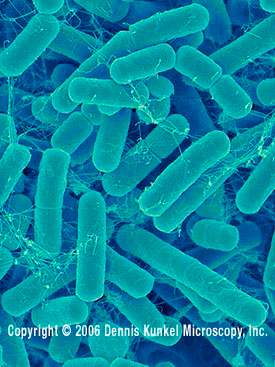16/04/2015
Expressão de hemolisinas em Bacteroides fragilis e seu papel na infecção intra-abdominal

Por Lobo LA, Jenkins AL, Jeffrey Smith C, Rocha ER.
Bacteroides fragilis é o patógeno oportunista isolado com maior frequência de infecções anaeróbicas. Há, entretanto, uma escassez de informações sobre os aspectos genéticos e moleculares da expressão gênica de seus fatores de virulência nas infecções intestinais. Um potencial mecanismo de virulência esta relacionado com a capacidade do B fragilis produzir hemolisinas.
Os resultados deste trabalho sugerem que as hemolisinas do B. fragilis são induzidas e reguladas diferencialmente in vivo. A estirpes parental e a mutante- hlyBA- atingiram níveis de aproximadamente 3–8 X 109 cfu/mL 1 dia após a infecção. No entanto, a estirpe mutante- hlyBA, após 8 dias de infecção diminuiu o número de células viáveis. Este é o primeiro estudo mostrando que a hemolisina HlyBA é um fator de virulência que desempenha um papel sobrevivência do na B. fragilis.
Expression of Bacteroides fragilis hemolysins in vivo and role of HlyBA in an intra-abdominal infection model
Lobo LA, Jenkins AL, Jeffrey Smith C, Rocha ER.
Department of Microbiology and Immunology, East Carolina University Brody School of Medicine, Greenville, North Carolina; Department of Medical Microbiology, Institute of Microbiology, Federal University of Rio de Janeiro, Rio de Janeiro, Brazil.
Abstract
Bacteroides fragilis is the most frequent opportunistic pathogen isolated from anaerobic infections. However, there is a paucity of information regarding the genetic and molecular aspects of gene expression of its virulence factors during extra-intestinal infections.
A potential virulence factor that has received little attention is the ability of B. fragilis to produce hemolysins. In this study, an implanted perforated table tennis “ping-pong” ball was used as an intra-abdominal artificial abscess model in the rat. This procedure provided sufficient infected exudate for gene expression studies in vivo. Real-time reverse transcription polymerase chain reaction (RT-PCR) was used to quantify the relative expression of hlyA, hlyB, hlyC, hlyD, hlyE, hlyF, hlyG, and hlyIII mRNAs. The hlyA mRNA was induced approximately sixfold after 4 days postinfection compared with the mRNA levels in the inoculum culture prior to infection. The hlyB mRNA increased approximately sixfold after 4 days and 12-fold after 8 days postinfection. Expression of hlyC mRNA increased sixfold after 1 day, 45-fold after 4 days, and 16-fold after 8 days postinfection, respectively. The hlyD and hlyE mRNAs were induced approximately 40-fold and 30-fold, respectively, after 4-days postinfection. The hlyF expression increased approximately threefold after 4-days postinfection. hlyG was induced approximately fivefold after 4 and 8 days postinfection. The hlyIII mRNA levels had a steady increase of approximately four-, eight-, and 12-fold following 1, 4, and 8 days postinfection, respectively. These findings suggest that B. fragilis hemolysins are induced and differentially regulated in vivo. Both parent and hlyBA mutant strains reached levels of approximately 3-8 × 10(9) cfu/mL after 1 day postinfection. However, the hlyBA mutant strain lost 2 logs in viable cell counts compared with the parent strain after 8 days postinfection. This is the first study showing HlyBA is a virulence factor which plays a role in B. fragilis survival in an intra-abdominal abscess model.
Referência:


